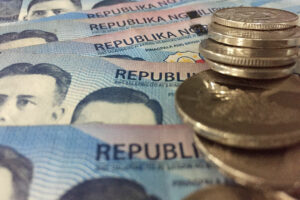THE PESO closed at a new record low against the dollar for the third straight day after the US Federal Reserve delivered another aggressive rate hike and signaled more increases to bring inflation under control.
The local unit closed at P58.49 versus the greenback on Thursday, down by 49 centavos from its P58 finish on Wednesday, data from the Bankers Association of the Philippines showed.
Year to date, the peso has weakened by 14.68% or P7.49 from its P51-per-dollar close on Dec. 31, 2021. Just for this month, the local unit has lost P2.345 in value against the dollar so far from its P56.145 finish on Aug. 31.
The peso opened Thursday’s session at P58.10 against the dollar. Its intraday best was at P58, while its worst showing for the day was at P58.50 versus the greenback.
Dollars exchanged increased to $1.51 billion on Thursday from $1.05 billion on Wednesday.
The local unit declined after the Fed hiked rates by 75 basis points (bps) overnight, Rizal Commercial Banking Corp. Chief Economist Michael L. Ricafort said in a Viber message.
The US central bank raised rates by 75 bps to between 3% and 3.25% on Wednesday and signaled they could go even higher to rein in high prices. It was the third hike of that size since May and brought cumulative increases for the year to 300 bps.
“Continued peso weakness, despite the latest +0.50 local policy rate hike to 4.25%, could lead to higher import prices and overall inflation, as the peso already depreciated by 14.7% since the start of 2022,” Mr. Ricafort said.
“Dollar strength from a more aggressive Fed in the aftermath of last night’s Federal Open Market Committee meeting is the main factor pressuring the peso lower today. This factor is unlikely to fade towards yearend,” MUFG Bank Currency Analyst Sophia Ng said in a note on Thursday.
“This, in addition to the likely widening of the Philippines’ trade and current account deficits as imports increase and export growth decelerates, would push the peso to new record lows against the dollar,” she added.
The Bangko Sentral ng Pilipinas (BSP) on Thursday raised benchmark interest rates by 50 bps for a second straight meeting amid broadening price pressures. It has now hiked borrowing costs by a total of 225 bps since May.
Headline inflation eased slightly to 6.3% in August from the near four-year high of 6.4% in July, bringing the eight-month average to 4.9%, both above the BSP’s 2-4% target for the year.
The central bank on Thursday hiked its average inflation forecast for this year to 5.6% from 5.4%.
For 2023, the BSP sees inflation averaging at 4.1%, also up from 4% previously, before slowing to decline to 3% in 2024, down from the 3.2% seen as of August.
For Friday, Mr. Ricafort gave a forecast range of P58.30 to P58.60 against the greenback.
BROAD DEPRECIATIONBSP Deputy Governor Francisco G. Dakila, Jr. said at a press briefing on Thursday that the local unit’s decline is broadly in line with regional currencies’ weakening versus the greenback due to broad dollar strength.
“The current movement of the peso is expected as it largely reflects the strengthening of the US dollar given the monetary policy tightening cycle of the US Fed. Now, concerns over the Russia-Ukraine conflict and its protracted impact on global supply chains, global growth uncertainty and elevated global inflation also continue to drive investors towards the US dollar as a safe-haven asset. So other currencies actually in the region are also seeing a pronounced weakening and volatility,” Mr. Dakila said.
“Our view is that the recent foreign exchange pressures are not unique to the peso. At the same time, the peso’s movements are a natural consequence of the prevailing current account dynamics of a growing economy, reflecting the increase in the country’s imports and with the ongoing economic recovery… as an inflation-targeting central bank, the BSP will respond to exchange rate fluctuations to the extent that they pose a risk to the inflation outlook,” he added.
Mr. Dakila said Thursday’s policy action is seen enough to help alleviate currency pressures while tempering inflation risks.
He said the BSP is ready to enter the foreign exchange market, but only to ensure orderly conditions and reduce excessive volatility in the currency.
“The BSP is also prepared to utilize other tools to respond to fluctuations in exchange rate and to ensure that legitimate demand for foreign currency is satisfied. Some of those tools have been implemented at the time, for example, when there was that taper tantrum some years back. The BSP also has a wide array of macroprudential measures in its toolkit that are available to respond to the challenges of maintaining financial stability,” Mr. Dakila said.
He added that the economy has adequate buffers against external headwinds. — Keisha B. Ta-asan
